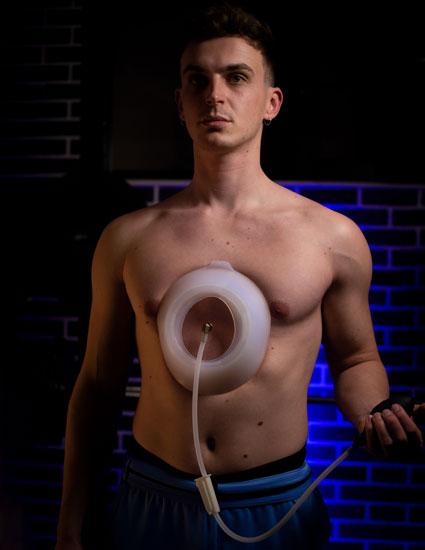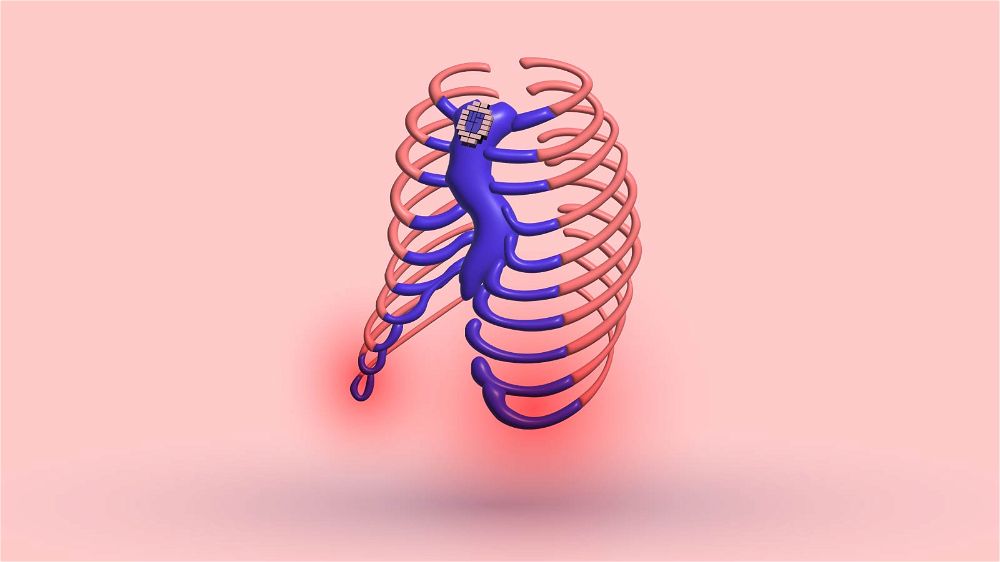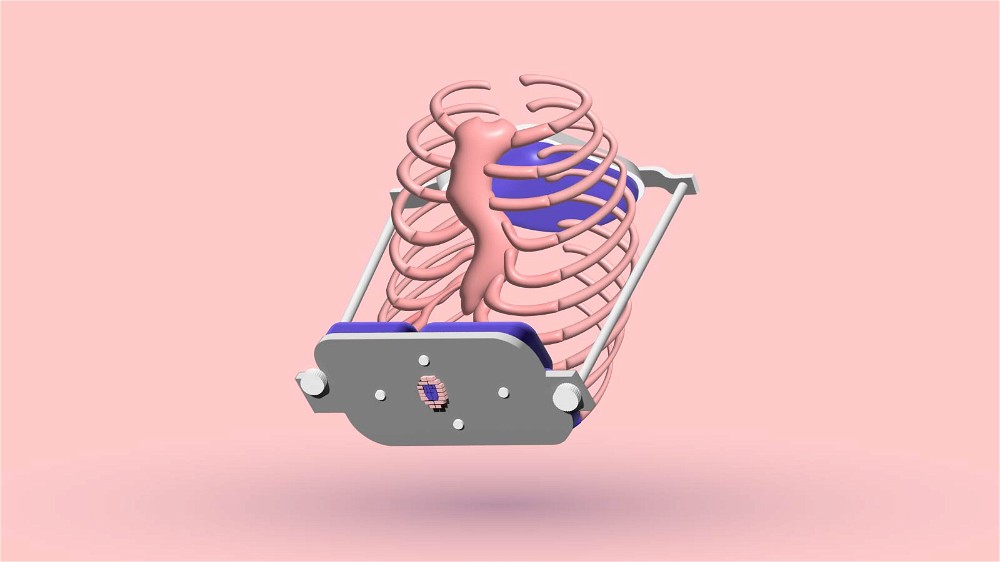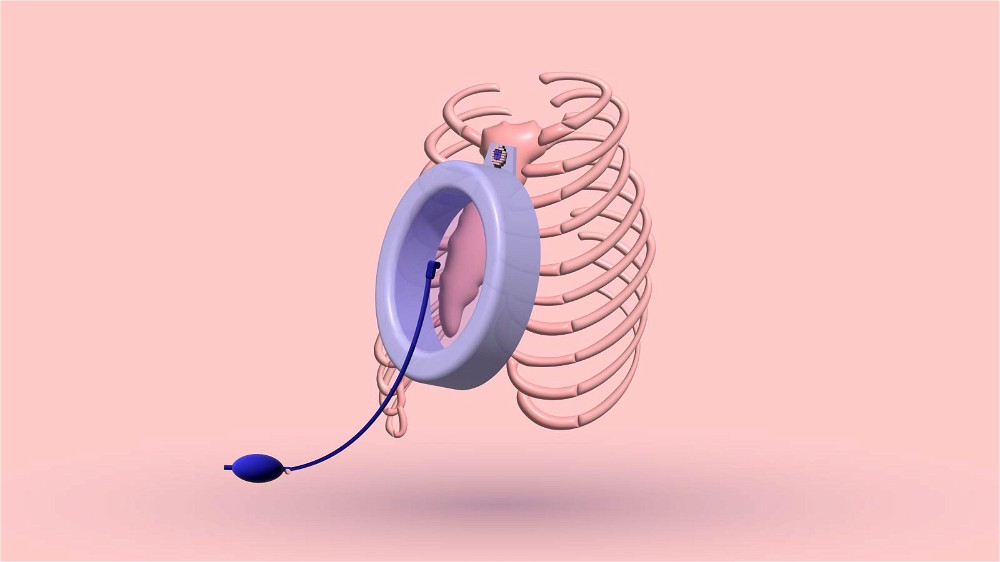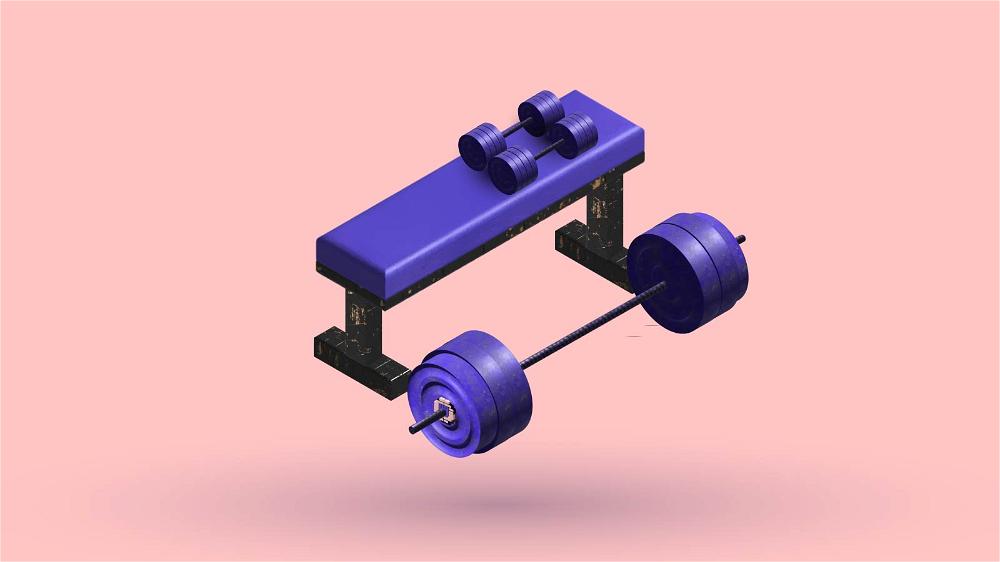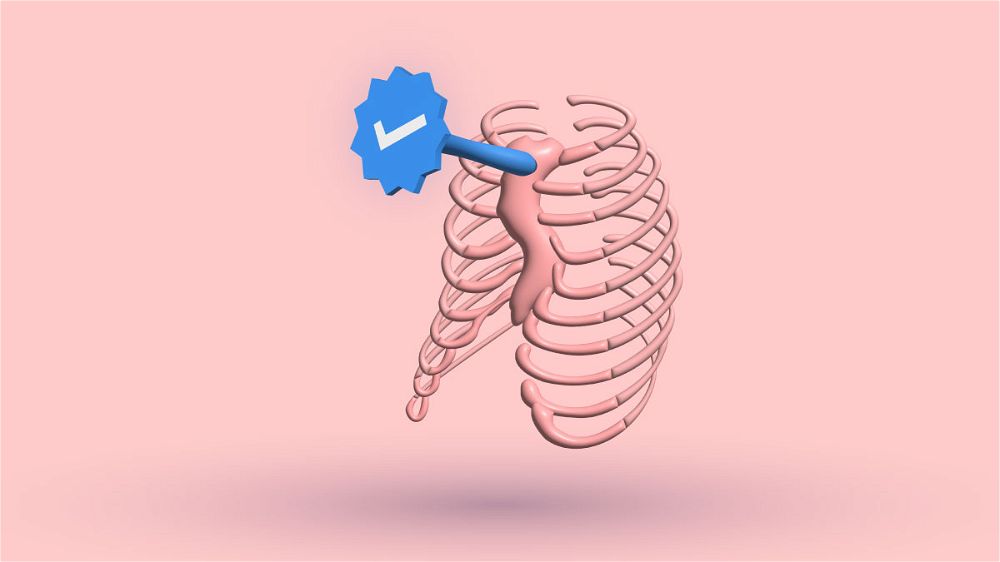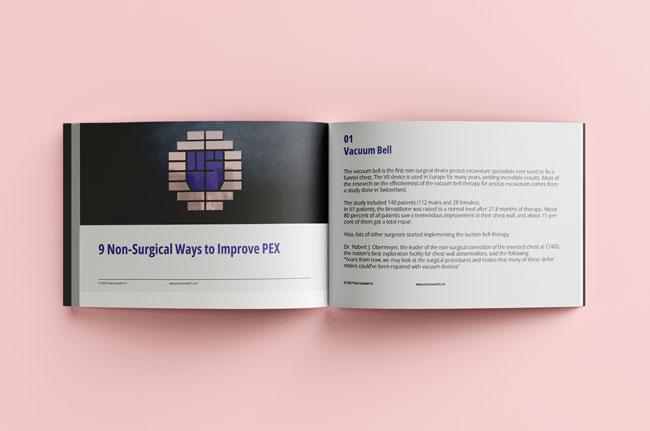As the saying goes, “as natural as breathing” doesn’t always apply if you’re a runner with pectus excavatum. Anyone who is a fan of running but has a sunken chest deformity knows that it can be hard to inhale enough oxygen to fulfill their body’s requirements.
If the deformity is severe, huffing and puffing as you run miles away is very common. This breathing difficulty is typically related to somebody who is out of shape.
However, suppose the runner is in great shape but still has breathing difficulty symptoms. In that case, it is probably the deformity causing the problems.
YOU AREN’T THE ONLY ONE WITH STAMINA PROBLEMS

It doesn’t matter if you’re an amateur, expert, or competitive runner. Trouble with breathing can occur in any situation, regardless of skill, age, or weight.
For amateur runners, inhaling and exhaling while running can feel like rocket science. Even if you consider yourself an expert runner, a lot can be improved when controlling your oxygen.
That is also relevant if you have a sunken chest. Don’t think you’re the only one with breathing troubles while running.
Even though pectus excavatum causes shortness of breath, I’ll share some tips you can use to improve your oxygen intake while running. Please don’t feel discouraged to start running because of your chest deformity.
BODY FUNCTIONING WHILE RUNNING WITH A CONCAVE CHEST

The most crucial factor to consider while running with an indented chest deformity is to ensure that the respiratory system operates appropriately. Every time your body goes through strenuous physical activity, your muscles need considerable oxygen to function correctly.
Because of this, your breathing system needs to work overtime. Please allow me to simplify the breathing process. While you are running, the air is inhaled into your body through your mouth or nose. Then, it flows directly to your lungs.
When it enters your lungs, it immediately gets swapped with carbon dioxide. After that, the oxygen is transferred across your body to vital organs and muscles. Meanwhile, the carbon dioxide is exhaled out of your body through your nose or mouth.
THE MAIN PROBLEM LINKED WITH PECTUS EXCAVATUM JOGGING

The problem with running with pectus excavatum is that your lung capacity is decreased because of the deformity. Depending on the severity of the condition, your VO2 max capacity will usually be lower than ordinary people's.
Your muscles are strong enough to endure the running. Because they are working hard to keep the tempo, they require a lot of oxygen.
Your lungs won’t be able to transfer adequate oxygen to the muscles and organs to satisfy their demands while you’re jogging. That is why runners with hollow chest conditions experience troubled breathing.
4 SIMPLE TIPS TO IMPROVE YOUR BREATHING WHILE RUNNING
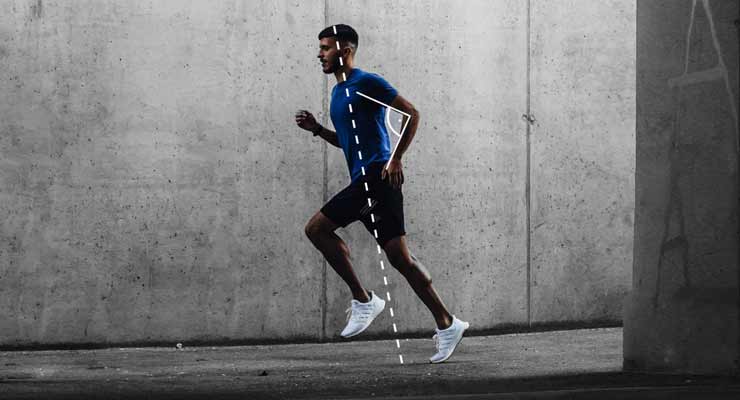
USE BOTH YOUR MOUTH AND NOSE
Many people think you should inhale only through your nose and exhale only out your mouth. However, that can minimize oxygen intake.
While running, I recommend you breathe through both airways every time. Do what feels natural for you. This will help you maximize oxygen intake. You will notice that you won’t feel as dizzy anymore.
PLEASE TAKE OFF YOUR HEADPHONES
To be a successful runner with pectus excavatum, you must listen to your breathing patterns. Running with loud music blasting in your headphones prevents you from getting in touch with your inhalation and exhalation.
You won’t be able to hear how loud you’re breathing. Listening to your body is the best way to get aware of it. If you’re breathing too loudly, that’s a clear sign that you’re out of breath and need to stop.
THINK ABOUT YOUR CHEEKS
Breathing is an automatic function of the body. The more you get exhausted while running, the more irregular your breathing becomes. If you’re gasping for air, that’s when you’re involved in shallow breathing.
There is a high chance that you may suck air in and out of your cheeks. Please make sure that you’re doing diaphragmic breathing throughout the jogging session.
You should feel your abdomen expanding while breathing, and not the cheeks. I understand that this is very hard to do at first. However, the more you do that, the more natural it becomes. Also, focus on slow exhalation.
STAND UP STRAIGHT
Pectus excavatum sufferers tend to slouch over while doing physical activity. That’s caused by muscular imbalances in the chest and the back. Also, the fear of showing their hollow chest to the world leads to a hunched-over posture.
The pectus excavatum community is known as “pectus posture.” I’ve seen plenty of people with sunken chest deformities participate in running. The first flaw that I noticed was their poor posture.
If you are slouching over, it will negatively affect your breathing. While running, ensure that your shoulders are back and your head isn’t leaning forward. That will allow for unhindered breathing and even longer strides.
LISTEN TO YOUR BODY
I suggest you watch what your body tells you while you run. If your deformity is severe, you might experience sharp pain in your ribs and sternum (breastbone). This is a big enough reason to dislike running. Evaluate how you feel and make sure you see your doctor.
You’ll probably go through a CT scan to measure how the dent in your chest affects your heart and lungs. If there is evident compression on your organs, your doctor will refer you to a cardiologist. Before running, make sure your doctor clears you for sports by considering your deformity.
LONG-DISTANCE RUNNING WITH PECTUS EXCAVATUM CAN BE DEMOTIVATING

Patients with inverted chests usually shy away from participating in sports activities. This is primarily because of psychological reasons. A study done by Malek showed the effects of pectus excavatum on distance runners.
Eighteen out of 21 concave chest sufferers performed an aerobic activity 30 – 120 minutes a day on average, three times a week. However, their maximal oxygen consumption was considerably lower with intense aerobic exercise than with sedentary people.
Also, their Lactic tolerance was very low. The authors of the study state that these irregularities result from heart impairment caused by pectus excavatum. To conclude, being a long-distance runner with pectus excavatum is very tough and demotivating.
No matter how hard you train, your competitors with regular chests will always have a higher VO2 max than you, even with exercising less. So, if you want to be a better runner, it is always a good idea to fix your pectus excavatum condition.
CAN RUNNING HELP YOU WITH THE INVERTED CHEST CONDITION?

Running can help you increase the stamina that you’re probably lacking. Also, it’ll help you with some of the mental symptoms caused by the deformity. Scientific research indicates that low regular physical levels can not explain decreased stamina fitness in kids with pectus excavatum.
I ALWAYS HATED LONG-DISTANCE JOGGING

While my pectus excavatum deformity was more severe, I used to play basketball. I was not too fond of conditioning drills like running across the gym and doing suicide drills (sprints). I was always a fast sprinter, but I sucked at long-distance running. I wanted to change that so intensively.
Also, I was aware of the importance of maintaining good cardiovascular health. Because of that, I started track running and have some tips that might help you.
The best advice that I can give you is to reduce speed. When I was starting, I paid zero attention to my running form. The mechanics of sprinting and running are different. I began running too quickly and paid no attention to my running form.
I felt terrible all the time at the track. Since I decelerated everything, I started practicing a more effective running form.
I still work on correcting my form to this day. After doing that, jogging is much easier for my lungs and joints. On top of that, my speed increased quite a lot. Be aware that your breathing will suffer because of your deformity. However, don’t let that demotivate you to quit running. Synchronize your breathing to your tempo.
Begin by inhaling in and exhaling out of your mouth instead of your nose. That way, the oxygen will get to your lungs more quickly. After some time, continue to breathe as it feels natural.
When starting, if your deformity is severe, you may experience heart palpitations and breathing tightness. If it is too bad, please stop and consult your doctor about whether running is suitable for you.
A CONVERSATION THAT INSPIRED ME TO START RUNNING

A few years ago, I had a conversation with an 18-year-old girl that suffered from a moderate to severe pectus excavatum. Nevertheless, she managed to get three varsity letters in running. She said that her breathing or heart functioning didn’t affect her in any visible manner in her four years of running.
She decided to see a specialist at the University of Michigan to be on the safe side. The specialist said that her physique was modified and adjusted to running because of running long distances. So, I advise you to start running and see how your body responds.
WHAT’S THE BEST ALTERNATIVE FOR RUNNING?


Suppose you struggle with running technique and breathing but still want to maintain good cardiovascular health. In that case, I recommend you try cycling for a while. You can go cycling, both indoors and outdoors. In the summertime, I am a huge fan of biking long distances.
I want to escape from the city and go to places I haven’t been to. I love to see the beauty of what nature has to offer. In the summer of 2019, I combined jogging and cycling. I carried my running gear in my backpack and cycled to the nearest trail. I realized I loved running on a trail more than on the road.
It was easier on my joints and my lungs because most of the natural air is unpolluted. However, the closest trail was 10 km away from my city. I concluded that the best way to get there was to warm up by cycling and running on the trail. That’s what I’ve done, and I saw tremendous improvement in my lung capacity and endurance.
RUN INTERVALS TO MAKE JOGGING EASIER
There are tons of benefits of interval training for athletes with pectus excavatum. Every single runner can benefit from this method.
It is one of the most popular training methods out there. It is perfect for a broad spectrum of runners, from beginners to professionals. It is not a new training method. It has been around for decades. Athletes first used it in running programs at the start of the 20th century.
Interval training was popularized by the Czechoslovakian runner Emil Zatopek, who won 3 gold medals at the 1952 Olympics. His 5k, 10k, and marathon preparation program followed this method.
MAIN BENEFITS OF INTERVAL TRAINING FOR PECTUS EXCAVATUM

Numerous studies were done to compare interval training with uninterrupted running. The studies concluded that better workout benefits could be accomplished with interval running, with the same training duration, compared to regular running.
Interval running enhances your aerobic, and anaerobic stamina increases your VO2 max capacity and improves your running form. What I love the most about this type of training is that it takes a short disruption of the intensity when you get exhausted and out of breath.
After the short rest period in between intervals, your body will feel rested and ready for another running phase. This is crucial if you’re suffering from pectus excavatum. You will feel these fantastic benefits after just a few weeks of training.
On top of that, the exercise effect on the muscles is more significant if you run intervals. This type of training can help you start loving running. The muscles will also need a lot of energy to rebuild during recovery. This is perfect if you’re also trying to drop weight.
HOW TO ADD INTERVALS IN YOUR RUNNING WORKOUTS
If you’re new to interval running, the best way to start is to follow a run-to-rest ratio of 1:2. That means 2 minutes of running followed by a 1-minute rest. Aim to finish at least ten intervals for a 30-minute workout.
After doing that, try to increase your running speed while reducing rest. You’ll be able to catch your breath during the one-minute rest. The best thing about this is that you’ll feel more confident while running with pectus excavatum.
You won’t feel like it is a grudge anymore. I started enjoying running after implementing this training method in my routine.

SCIENCE SUPPORTS INTERVAL RUNNING
Interval running is the most effective type of cardiovascular exercise. It is proven to bring benefits faster than typical cardio workouts that can be too taxing.
Recent studies showed that 27 minutes of High-Intensity-Interval-Training, performed three times a week, produces the same aerobic and anaerobic effects as 60 minutes of cardio. Interval running can get you in shape more quickly.
A study done in 2011 showed that two weeks of high-intensity interval running could increase your aerobic capacity as much as eight weeks of long-distance endurance jogging. This training method will save you valuable time that you can use for other activities.
CAN YOU COMBINE WEIGHTLIFTING AND HIGH-INTENSITY INTERVAL RUNNING?
Combining bodybuilding and high-intensity interval running is the perfect blend for dealing with the negative consequences of pectus excavatum. Bodybuilding is fantastic for building muscle mass and muscle toning.
Most pectus excavatum sufferers are ectomorphs (characterized by a thin frame and trouble gaining weight). They need to eat in a caloric surplus and increase their time in the weight room to see noticeable improvements in their physique.
That’s a fantastic way to make the dent in the center of your chest much less noticeable. Integrating cardiovascular activities like running would be best to stay on top of your physical game.
That will help you increase your VO2 max capacity and improve your overall endurance. You’ll notice a lower occurrence of shortness of breath, which is always a great plus.
Improving your physique through weightlifting and high-intensity running will also remarkably impact your psychological health. You’ll start walking upright with your chest up, full of confidence.
You’ll instantly get a quick confidence boost after you check yourself naked in the mirror. If you continue this for over a year, your life will improve. This is the exact path that I’ve chosen.
I installed the unshakeable discipline in myself. I now have the confidence to take over any challenge and get the best out of it. Some may question whether running with the combination of weightlifting wastes a lot of time in the day or week. To be honest, it does.
However, I wouldn’t think of a better way to spend your time, especially if you want to correct your pectus excavatum deformity without surgery.
RUNNING HELPS PSYCHOLOGICALLY
Ever since I started running and hiking more regularly, I have felt much happier and have a more positive outlook on life. If you run with the inverted chest wall deformity, it will help you both psychologically and physically.
It is also a simple activity highly recommended for everyone, including males, females, adults, children, and even people of age. Give running a chance for at least a month, and see how your body feels. Even though it can be painful, you won’t regret it.
BUY PROPER RUNNING GEAR
Finally, I recommend you purchase the right running gear. Investing in a pair of running shoes will do wonders for your running. Please stop doing every single physical activity in only one pair of shoes. There are reasons why sportswear companies create sneakers for every sport.
Your running stride will immediately feel more natural if you wear running shoes. Also, your ankle and knee joints won’t take a lot of toll while running on concrete.
CONCLUSION
Don’t use pectus excavatum as an excuse not to participate in running. Even though science has proved that your lung and the VO2 max capacity are reduced due to the deformity, running is still a great way to improve your overall health.
To improve your physical appearance, I highly recommend you combine running and bodybuilding. You’ll be able to build muscle while improving your cardiovascular health and shedding excess fat.
I recommend interval training if you’re having trouble breathing while running long distances. On top of that, use the four best running tips for the pectus excavatum deformity I mentioned above. I promise that you’ll be able to run longer distances while controlling your breathing.
15 Sources
- Winkens R, Guldemond F, Hoppener P, Kragten H, van Leeuwen Y. Pectus excavatum, not always as harmless as it seems. BMJ Case Rep. 2009 Dec
14;2009:bcr10.2009.2329. - Oxygen Consumption and Usage During Physical Exercise: The Balance Between Oxidative Stress and ROS-Dependent Adaptive Signaling - PMC [Internet].
[cited 2022 Dec 3]. Available from: https://www.ncbi.nlm.nih.gov/pmc/articles/PMC3579386/ - How the Lungs Work - The Lungs | NHLBI, NIH [Internet]. [cited 2022 Dec 3].
Available from: https://www.nhlbi.nih.gov/health/lungs - The Value of VO2 Max Testing in Athletes [Internet]. Verywell Fit. [cited 2022 Dec
3]. Available from: https://www.verywellfit.com/what-is-vo2-max-3120097 - How to Breathe While Running (Try These Techniques) [Internet]. [cited 2022
Dec 3]. Available from: https://www.womensrunning.com/training/beginner/steps-breathe-easier-run/ - Pectus Excavatum Clinical Presentation: History, Physical Examination [Internet]. [cited 2022 Dec 3]. Available from: https://emedicine.medscape.com/article/1004953-clinical#b4
- Malek MH, Coburn JW. Strategies for Cardiopulmonary Exercise Testing of Pectus Excavatum Patients. Clinics. 2008 Apr;63(2):245–54.
- Effect of Pectus Excavatum Deformity on Cardiorespiratory Fitness in Adolescent Boys | Adolescent Medicine | JAMA Pediatrics | JAMA Network [Internet].
[cited 2022 Dec 3]. Available from: https://jamanetwork.com/journals/jamapediatrics/fullarticle/486171 - CARDIO_TRAINING (1).pdf - PECTUS TRANSFORMATION PROJECT CARDIO CARDIO FOR PECTUS Cardio is great for Pectus Excavatum itself because Pectus Excavatum | Course Hero [Internet]. [cited 2022 Dec 3]. Available from:
https://www.coursehero.com/file/96110864/CARDIO-TRAINING-1pdf/621 - Emil Zátopek. In: Wikipedia [Internet]. 2022 [cited 2022 Dec 3]. Available
from: https://en.wikipedia.org/w/index.php?title=Emil_Z%C3%A1topek&oldid=1116523422 - Why Every Runner Can Benefit from Interval Workouts - Runners Connect [Internet]. [cited 2022 Dec 3]. Available from: https://runnersconnect.net/runningintervals-fitness/
- Interval Running: Guide, Benefits, and Helpful Apps [Internet]. [cited 2022
Dec 3]. Available from: https://www.healthline.com/health/fitness/interval-running - What is HIIT (High Intensity Interval Training)? [Internet]. [cited 2022 Dec 3].
Available from: https://northernbootcamp.co.uk/hiit-high-intensity-intervaltraining/ - Your Body Type - Ectomorph, Mesomorph or Endomorph? [Internet]. Muscle
& Strength. 2006 [cited 2022 Dec 3]. Available from: https://www.muscleandstrength.com/articles/body-types-ectomorph-mesomorph-endomorph.html - The Best Running Clothes & Gear for Beginners [Internet]. Verywell Fit. [cited
2022 Dec 3]. Available from: https://www.verywellfit.com/basic-running-clothesfor-beginners-2911840




